FINAL DESTINATION Saga (2000-2011)
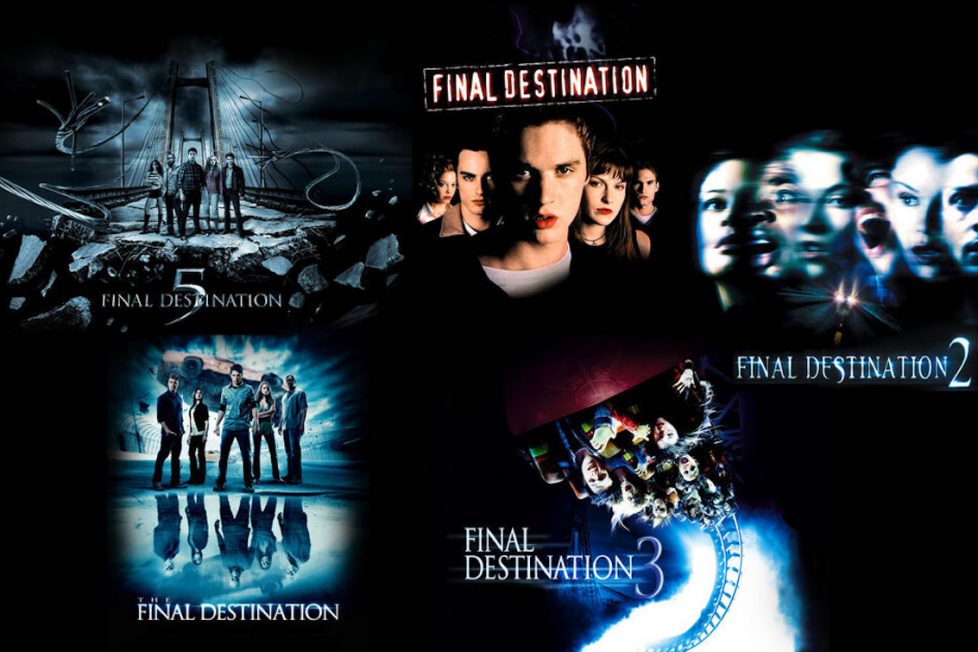
Stop me if you’ve heard this one before: you’re pouring ice-cold vodka into a mug that recently contained a hot beverage and, naturally, the mug cracks. You carry that cracked mug over to your computer and it drips along the floor and into the back of your PC. The computer starts smoking, the screen explodes, and shards of glass are launched at your throat. As you’re stumbling helplessly around the room, the computer situation takes a turn for the worse as the fire catches the trail of vodka you dripped on the ground, leading it directly back to the bottle on the counter, which also explodes. You reach for a dish towel to apply pressure to your wounds but, unfortunately, that just pulls a knife block off the shelf and your butcher knife lands precisely in the middle of your chest. And, as if your day couldn’t get any worse, your house finally explodes!
Maybe this isn’t a common occurence in reality, but in the Final Destination universe, it’s business as usual. In a film series that routinely varied in setting, tone, and, let’s face it, quality, there was one consistent thread running through all five movies: explosively bloody Rube Goldberg-esque set-pieces in which teens died in the most ludicrous ways imaginable.
20 years after the release of the original Final Destination, it still stands as the first and best horror franchise of the 21st-century—a last gasp for blood-soaked campiness before genre trends pivoted to humourless torture porn, remakes, and reboots.

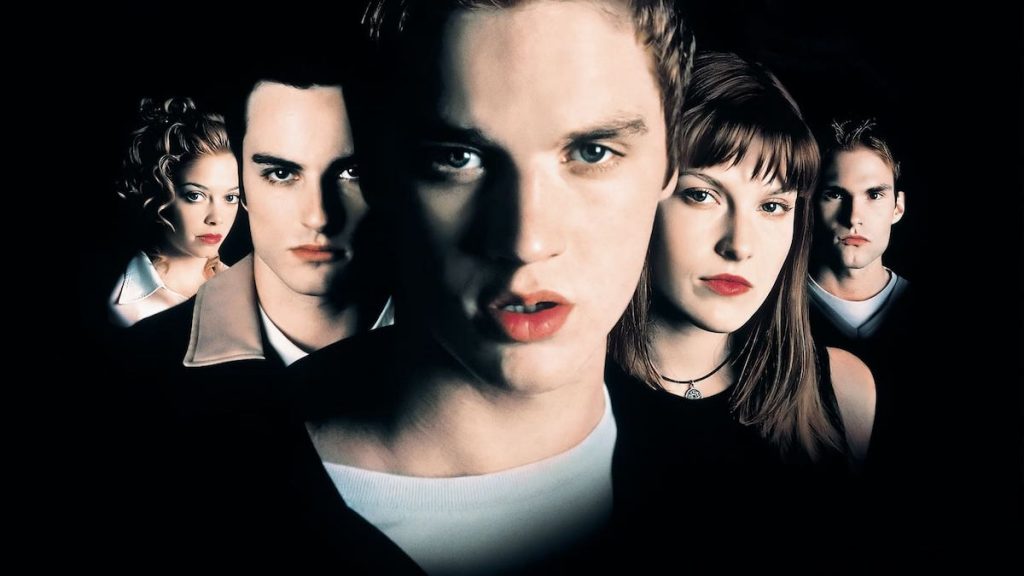

For a film with such an unmistakable look and feel, the original Final Destination was born from comparatively humble origins. Writer Jeffrey Reddick pitched an early version of the concept as a spec script The X-Files‘ writer-producers James Wong and Glen Morgan read. Morgan and Wong apparently loved the premise almost too much, agreeing with New Line Cinema that it would work better without the constraints of a pre-established television universe, and together the three of them fashioned a new, slicker, bloodier screenplay for Final Destination as a movie. Wong took over as director while Reddick and Morgan joined him as co-writers, fashioning a unified vision of hapless teens trying and failing to escape their spectacularly gruesome fates.
That first film is hardly subtle in evincing the tone of what’s to come. You can’t say they didn’t warn you with an opening that involves ominous pans over a copy of Death of a Salesman, a quick glimpse of a magazine spread about Princess Di’s death, and mysterious zooms on potentially frightening double entendres like “terminal”. Are you sensing a theme here? Of course, the one recurring gag of the first movie, that nobody can forget, for better or worse, is John Denver’s “Rocky Mountain High” playing over and over again to foreshadow bad luck and, occasionally, death for the many unwitting characters.
How did the most innocuous singer-songwriter of the 1970s become a harbinger of doom for Y2K teens? Well, naturally, because Denver died young in a plane crash; a fate that Alex (Devon Sawa) and his classmates were also to experience were it not for Alex’s vivid premonition of a mechanical malfunction that leads to the plane combusting shortly after take-off. His freakout causes half his class to evacuate the plane, only to watch stunned from the departure lounge as his vision comes true down to the last detail. Survivor’s guilt notwithstanding, it’s almost too good to be true that these kids and their teacher so narrowly escape death. Unfortunately, it is too good to be true, and, as foreboding mortician William Bludworth (Tony Todd) tells them, nobody escapes Death’s plan. And so, one by one, Flight 180’s survivors get picked off in head-scratching coincidences, all preceded by John Denver’s crooning.
The premonition that sets the story rolling is never explained, nor are the similar occurrences that kickstart every sequel. It’s a sort of unspoken agreement with the audience that if we suspend our disbelief we’ll get to see some of the most outrageously mindless violence to ever grace the silver screen. The closest thing to an explanation we do get is a news report that gives insight into why these teens are dying in the order they are, and in case that literal-minded exposition isn’t clear enough, Alex draws some crude diagrams and explicitly spells out which characters will die next.
Of course, knowing who dies and when is hardly a spoiler because the premise is driven less by plot than by ‘what if’ scenarios prompted by a mix of obvious omens and skewed set design that creates a constant sense of unease. In one particularly foreboding scene, a character is standing in front of his sink in the bathroom as a puddle of water races towards him. He picks up a razor (what if he slips and cuts his neck?) and then starts plucking his nose hairs (what if the scissors are thrust up his nostril?) and finally plugs in his boombox (John Denver, duh) and uplugs it again only to place the plug just out of reach of the seemingly sentient puddle.
Oddly enough, none of this is played for much humour. Unlike the sequels that got a morbid kick out of the gore and absurdity, the original Final Destination is a deadly serious affair, playing out its ridiculous situations with a more-or-less straight face. That’s not to say there isn’t some unintentional comedy here: when Alex’s friend Clear Rivers (Ali Larter) shows him a sculpture comprised of a rusty metal spring with a question mark on top she tells him, “this is you. Not a likeness, but how you make me feel,” a statement that in this cinematic universe is devastating enough to prompt a grave, “I’m sorry” from Alex.
USA | 2000 | 98 MINUTES | 1.85:1 | COLOUR | ENGLISH • FRENCH
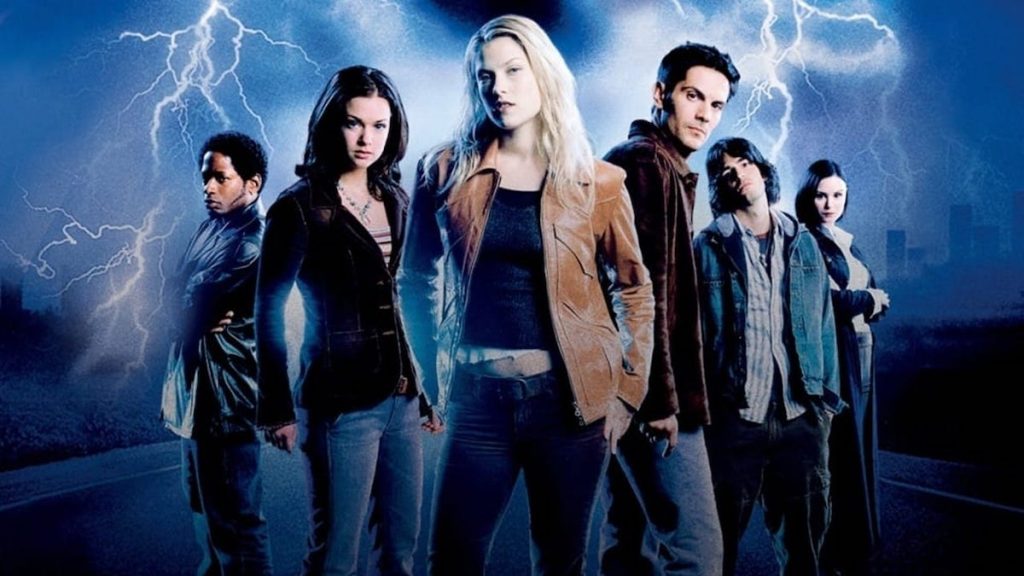

That humourless façade goes straight out the window with the first sequel. Everything about Final Destination 2 is bigger, louder, and more mind-bogglingly stupid than the original. Gone is all pretence of plot, too. It’s already just a series of dumb-as-dirt set-pieces that run the gamut from a character fatally slipping on spaghetti to two people trapped in an elevator with a box full of prosthetic hook hands. It’s as much a highlight reel as a movie, which makes it electrifying during the tightly choreographed death sequences and stone-cold boring in every scene in-between. It’s two steps forward, one step back. A worse film than the ones that came before and after, but also a lighter and more confident follow-up to the tonally sloppy original.
This time around, a whole new cast of characters led by Kimberly Corman (Criminal Minds‘ A.J. Cook) survive a catastrophic pile-up on the highway, preceded by a realer-than-real premonition, of course, and they’ve once again get picked off one by one in the coming weeks. Ali Larter returns to reprise her role as Clear Rivers seemingly for the sole purpose of creating a more apparent connection to the previous film, as does Tony Todd as William Bludworth. Bludworth, who may or may not be the the embodiment of the supernatural force that’s offing these teens, was crucial to the first film’s mythology but is more or less treated with a cameo here, a head-scratching creative choice that will become a trend for the rest of the series.
Aside from more frequent premonitions, the formula goes virtually unchanged, although the ratio of plot-to-deaths has shifted noticeably in favour of the latter. It’s frequently hilarious, but with so little characterisation and plot to provide a foundation for its conceit it struggles to sustain itself for even a brisk 90-minutes. By the time the characters are in a race against time in the last act, it’s already started to feel more like an endurance test than anything else. Thankfully, the final moments end up bouncing back in typically explosive fashion, creating one of the most unforgettable closing scenes of the entire franchise.
USA • CANADA| 2003 | 90 MINUTES | 1.85:1 | COLOUR | ENGLISH
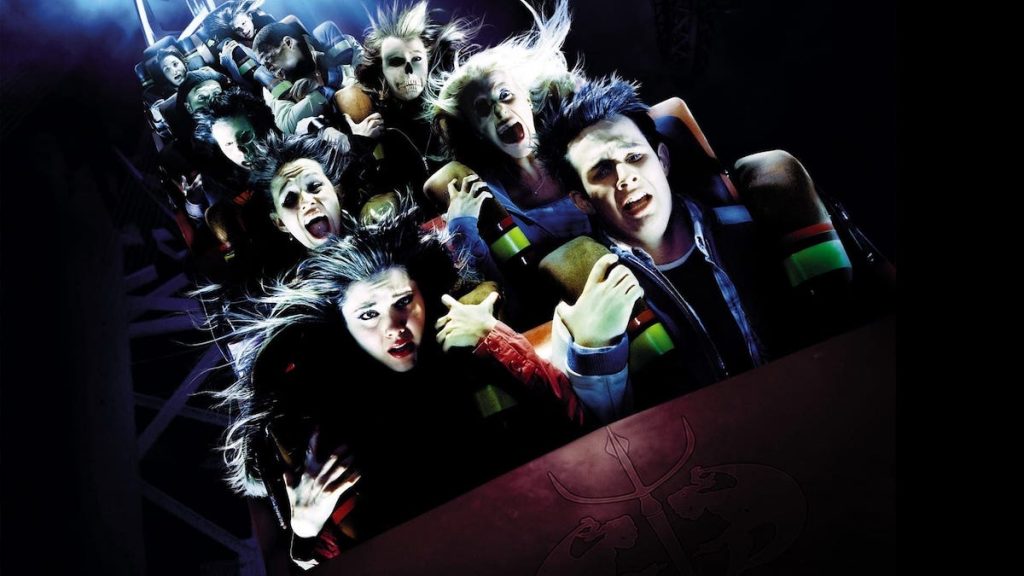

After critics and audiences both concluded the second entry felt uneven, James Wong returned to the director’s chair for Final Destination 3. The heart and soul of the franchise returned with him, as the characters have actual personalities again and, in a franchise first, we actually care about what happens to them! Things loosen up considerably since he directed the first movie, and this time around there’s no confusion about whether the humour is intentional or not.
This time around, the vision-burdened protagonist is Wendy (Mary Elizabeth Winstead), a high school student who sees her friends dying in typically gruesome fashion onboard a rollercoaster destined to crash. Wendy’s variation on the theme, however, is that she’s a photographer, and her photos of friends from the night of the accident contain convoluted clues regarding the order and circumstances of their impending deaths.
While the initial rollercoaster accident is far from the most exciting large-scale accident of the series, everything that follows is braindead horror heaven. The tanning salon sequence is arguably one of the best of the saga, a chain reaction of inconsequential details snowballing into a hilarious, double-fatality catastrophe soundtracked to “Love Rollercoaster.” The biggest tragedy in horror film history is, without question, Paris Hilton’s decision to star in the House of Wax (2005) remake instead of in Final Destination 3 as one of the two twins clearly both modelled after her. Her absence is dearly missed, but that doesn’t stop that scene (and everything before and after it) from scratching some elusive horror movie itch I didn’t know I had.
It doesn’t hurt that there’s a real actor fronting the cast this time (no offense, Devon Sawa and A.J. Cook). Wendy is the first sympathetic character of the series, probably due more to Winstead’s performance than to the typically flimsy script. It’s not exactly high art, but having a semi-rounded character at the centre of a movie like this doesn’t hurt to make it a lot more entertaining. Combine that with some of the bloodiest deaths of the franchise so far, including not one but two characters literally exploding into pulp, and it feels like the promise of the first two entries finally lived up to.
USA | 2006 | 86 MINUTES • 93 MINUTES (UNCUT) | 2.39:1 | COLOUR | ENGLISH
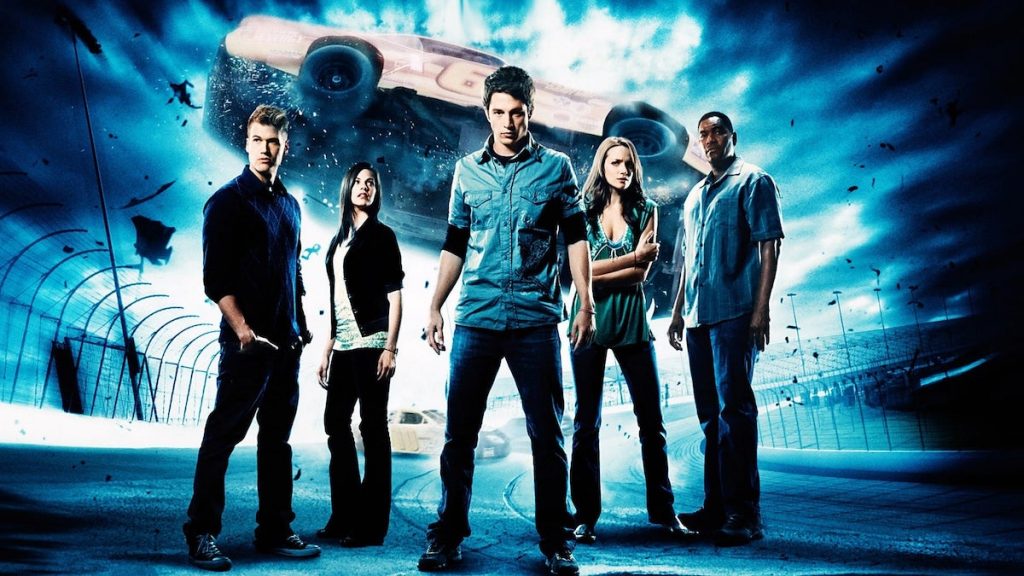

Naturally, when Warner Bros. took over from New Line Cinema, they decided their best move would be to axe the director of the third and best movie and re-hire David R. Ellis, who made the messier Final Destination 2. The resulting film, annoyingly titled The Final Destination in a break from the franchise’s numbering, was a manifestation of everything the series’ harshest critics wrongly claimed before: a Final Destination movie where the crassness outweighed the fun.
Once again, there’s a teen experiencing vivid premonition of a fatal disaster, although it’s clear the well has started to run dry. Nick (Bobby Campos) and his friends are at a NASCAR race that goes awry when a car goes flying off the tracks and into the stands. Beyond the inciting crash which more or less lives up to series standards though, any pretence of cleverness in the elaborate butterfly-effect disasters is dismissed in favour of more gore, more deaths, and an abundance of low-grade CGI. In theory, a movie that’s made up almost entirely of gory set-pieces should be a dream for fans, but when it feels this lazy and mundane it’s hard to maintain interest.
Everything about The Final Destination is low-effort, embodying the depressing strain of gross-but-boring 2000s horror pioneered by Eli Roth with films like Cabin Fever (2002) and Hostel (2005). This is a movie so phoned-in that four characters with not-insignificant screen time are listed in the credits as “racist,” “racist’s wife,” “MILF,” and “MILF’s husband.” Maybe seeing this in 3D as intended make up for some faults (as the death scenes are heavily reliant on eyeballs and other VFX-created viscera flying at the camera) but without that hi-tech distraction to cover up for it, it stands as the only entry in this series devoid of personality.
USA | 2009 | 82 MINUTES | 2.39:1 | COLOUR | ENGLISH
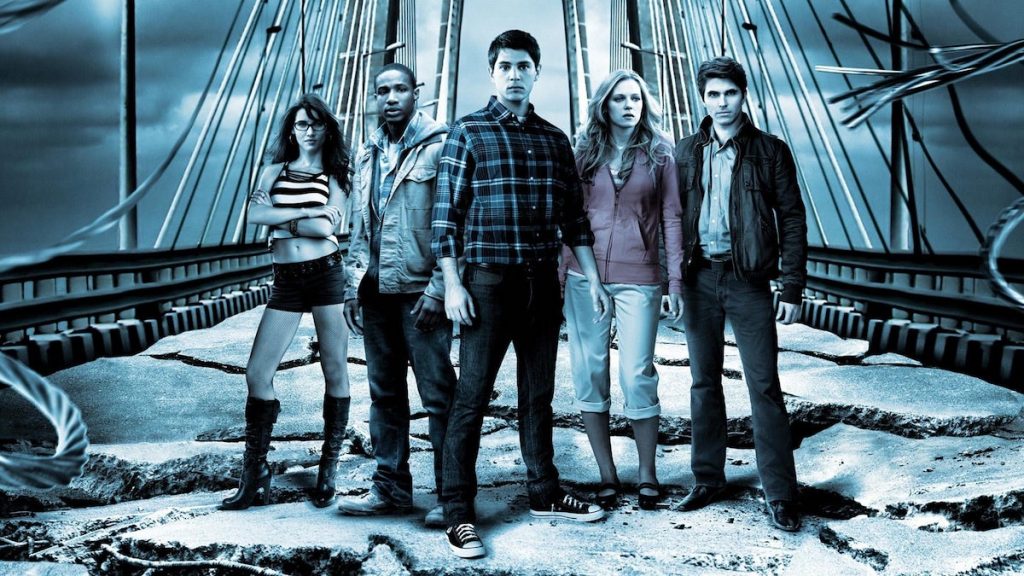

Like a phoenix rising from the ashes, there was one final Final Destination in store for audiences two years later. Final Destination 5 is the only film in the franchise to earn a positive consensus from critics—and for good reason. Stylish, visually spectacular, and funnier than the series had been in years, it feels like the culmination of all the potential built up from the films leading into it. Even the plot and characters, an aspect that these movies have famously neglected in favor of action, are sketched well enough to make the death and near-death scenes genuinely suspenseful again. It turns out the trick to making a good horror movie is to take 15-minutes to establish the characters about to be gruesomely dispatched…. who would have thought? Sam (Nicholas D’Agosto) is our hero this time, predicting a bridge collapse just in time for half of his corporate retreat bus to escape unscathed. So far so familiar, but this time around there’s a twist: they can extend their lives and escape death by killing someone else, stealing their life-force. Clearly this is not Shakespeare, but some variety and some sympathetic characters are all a film like this needs to go from guilty pleasure to modern horror staple.
The Final Destination series will never earn the relative respect that slasher franchises like Friday the 13th, A Nightmare on Elm Street, and Halloween hold, largely because it was so wildly inconsistent in quality. Although anyone who has seen Freddy’s Dead: The Final Nightmare (1989), Jason X (2001) or Halloween: Resurrection (2002) knows the more classic franchises are hardly immune to misfires. But it’s mainly because it took 11 years for them to perfect the formula. By the time they nailed it with the fifth entry, audiences had started to experience Destination-exhaustion and there wasn’t much of a market to keep cranking out sequels.
Any franchise that draws viewers back for five years over more than a decade clearly is doing something right, though, and Final Destination certainly tapped into a horror niche that had remained criminally underserved since the end of the slasher heyday in the late 1980s. These fast, campy, larger-than-life neo-slashers distilled a horror formula to its essence while also updating it for the generation of MTV and ADHD, dialing it up to 11 at every turn. With rumours now swirling of a sixth film having been in the works just prior to the COVID-19 pandemic, it may not be long yet before we finally reach the (hopefully not) Final Destination.
USA | 2011 | 92 MINUTES | 2.39:1 | COLOUR | ENGLISH

directors: James Wong (1,3), David R. Ellis (2, 4) & Steven Quale (5).
writers: Jeffrey Reddick (1-2), James Wong (1,3), Glen Morgan (1,3), J. Mackye Gruber (2), Eric Bress (2,4) & Eric Heisserer (5).
starring: Devon Sawa, Ali Larter, Kerr Smith, Seann William Scott, A.J. Cook, Michael Landes, Mary Elizabeth Winstead, Ryan Merriman, Kris Lemche, Bobby Campo, Shantel VanSanten, Krista Allen, Mykelti Williamson, Nicholas D’Agosto, Emma Bell, Miles Fisher, Arlen Escarpeta, Courtney B. Vance, David Koechner & Tony Todd.
